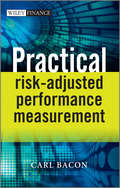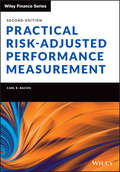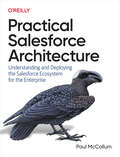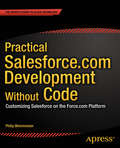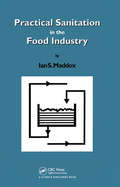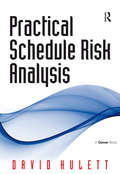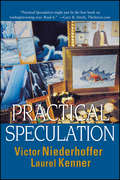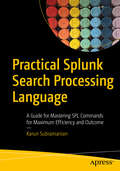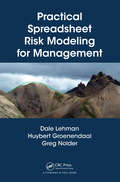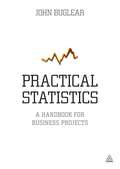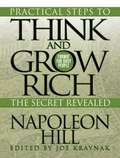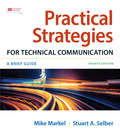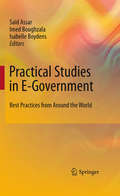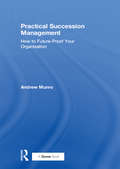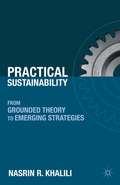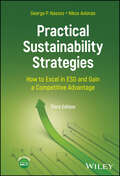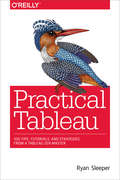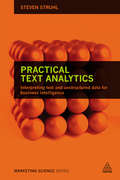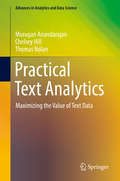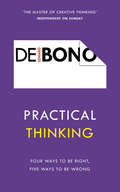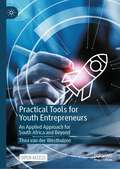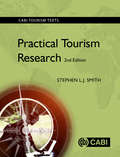- Table View
- List View
Practical Risk-Adjusted Performance Measurement
by Carl R. BaconA practitioner's guide to ex-post performance measurement techniquesRisk within asset management firms has an undeserved reputation for being an overly complex, mathematical subject. This book simplifies the subject and demonstrates with practical examples that risk is perfectly straightforward and not as complicated as it might seem. Unlike most books written on portfolio risk, which generally focus on ex-ante risk from an academic perspective using complicated language and no worked examples, this book focuses on ex-post risk from a buy side, asset management, risk practitioners perspective, including a number of practical worked examples for risk measures and their interpretation.
Practical Risk-Adjusted Performance Measurement (The Wiley Finance Series)
by Carl R. BaconExplore different measures of ex-post risk-adjusted performance measurement and learn to choose the correct one In the newly revised Second Edition of Practical Risk-Adjusted Performance Measurement, accomplished risk and investment expert Carl R. Bacon delivers an insightful, accessible, and real-world guide to ex-post risk measurement. The author bridges the gap between theory and practice, showing you how to apply the former to the latter without introducing unnecessary mathematical complexity. The book describes the fundamentals of risk in the asset management context and the descriptive statistics used to describe it. It builds on that foundation with detailed examinations of concepts like regression, drawdown, and partial moments, before moving on to topics like fixed income risk and Prospect Theory. With helpful additions that include recently developed measures of risk, supplementary explanatory sections, and six brand-new chapters, this book also offers: A practical classification of all ex-post risk measures and how they connect to one another An explanation of how risk-adjusted performance measures impact performance fees A discussion of risk measure dashboard designs Instructions on how appraisal measures should be used for manager selection Perfect for portfolio managers, asset owners, risk controllers, and investment performance analysts, Practical Risk-Adjusted Performance Measurement is an indispensable resource for anyone looking for a hands-on exploration of the buy-side, asset management perspective.
Practical Salesforce Architecture: Understanding and Deploying the Salesforce Ecosystem for the Enterprise
by Paul McCollumOnce renowned as a customer relationship management tool, Salesforce has evolved into a cloud-first application and capability ecosystem. With dedicated components for tasks such as middleware, big data, reporting, ETL, data loading, and API orchestration, Salesforce has become more prevalent in modern architectures.This concise yet comprehensive guide provides an overview of Salesforce architecture for enterprise architects and Salesforce ecosystem architects. Author Paul McCollum, Salesforce Technical Architect at Accenture, provides a roadmap for integrating major elements of the Salesforce ecosystem with planned or existing enterprise architecture. You'll learn how to use these components to address the diverse needs of different organizations.Many companies today are adding or building multicloud capabilities and incorporating various elements from the Salesforce ecosystem. With this book, you'll learn:Strengths, weaknesses, and growth areas of Salesforce's enterprise architecture domain featuresHow Salesforce compares to other cloud providersMethods for using the Salesforce ecosystem effectively to address your organization's needsHow to integrate Salesforce with planned or existing enterprise architecturesWays to manage and forecast performance, complexity, and ease of operation across the Salesforce platform
Practical Salesforce.com Development Without Code
by Philip WeinmeisterAre you facing a challenging Salesforce. com problem--say, relating to automation, configuration, formulation, or reporting--that you can't quite crack? Or maybe you are hoping to infuse some creativity into your solution design strategy to solve problems faster or make solutions more efficient? Practical Salesforce. com Development Without Code shows you how to unlock the power of the Force. com platform to solve real business problems--and all without writing a line of code. Adhering to Salesforce. com's 'clicks, not code' mantra, Salesforce. com expert Phil Weinmeister walks you through different business problems and identifies effective, creative--and proven--approaches to solutions using the platform's declarative framework. If you are a Salesforce. com administrator, analyst, consultant, or developer, you can attest to the insatiable appetite of users for new functionality. Your clients expect solutions--and now. By adopting Practical Salesforce. com Development Without Code as your guide, you will learn how to deliver business solutions within Salesforce. com by combining analysis, creativity, and logic with some of its core elements, including validation rules, workflow rules, and formula fields. In addition, Weinmeister dissects and explains the most useful functions and features for developers, and shows you how to use them. Among other things, you will learn how to: Build objects, fields, and relationships to establish a sensible data modelAutomate business processes by using workflow rules and flows (Visual Workflow)Utilize functions and develop formulas effectively for a variety of business needsDevelop intricate approval processes to handle exception scenariosEmploy publisher actions to drive additional functionality from the Chatter feedManage your data using Data LoaderBest of all, Weinmeister uses real-life business scenarios and visuals to keep you engaged and learning something new with every page you read. Practical Salesforce. com Development Without Code will help you absorb the principles behind dozens of creative and thoughtful ways to solve your business problems. Applying the lessons learned from this how-to guide will ultimately save you time and ensure that your clients or internal customers are well satisfied and productive
Practical Sanitation in the Food Industry
by Ian S. MaddoxThis book provides a clear, practical approach to sanitation in the food industry. The content ranges from the principles of microbial growth, through descriptions of cleaning chemicals, to the management of Hazard Analysis Critical Control Point (HACCP) systems. It will be an invaluable basic text for all tertiary students who intend to work in the food industry, as well as for the existing industry personnel.
Practical Schedule Risk Analysis
by David HulettProject scheduling is required for good project management, and the schedule represents the project plan under a specific set of assumptions, often that it will avoid new risks or even those that have occurred on previous occasions. The typical Critical Path Method (CPM) schedule assumes that the project team knows how long the scheduled activities will take. Yet, the experienced project manager knows that duration values so precisely stated are actually only estimates based on assumptions that could be wrong. A schedule risk analysis explores the implications for the project's schedule of risk to the activity durations and also identifies the most important schedule risks. This analysis, building on and extending CPM scheduling, will result in a more accurate estimate of completion and provide an early opportunity for planning effective risk mitigation actions. Practical Schedule Risk Analysis contains a complete treatment of schedule risk analysis from basic to advanced concepts. The methods are introduced at the simplest level: * Why is the duration uncertain? * And how do we represent this uncertainty with a probability distribution? These are then progressively elaborated: * How does uncertainty of activities along a path lead to more uncertainty of the path's completion date? * How can a schedule with parallel paths be riskier than each of the paths individually? * How can we represent risks about activities that are not in the schedule at all? Culminating in a discussion of the most powerful and advanced capabilities available in current commercial software. Schedule risk analysis is a process that is industry-independent, and the methods explained in this volume have been used by the author with positive effect in such industries as construction, oil and gas, information systems, environmental restoration and aerospace/defense. The result is a book that is not only highly practical; something that people within all types of projects and in all industries can apply themselves; but that is an extraordinarily complete guide to creating and managing a rigorous project schedule.
Practical Speculation
by Victor Niederhoffer Laurel KennerThe follow-up to Victor Niederhoffer's critically and commercially acclaimed book The Education of a Speculator has finally arrived. Practical Speculation continues the story of a true market legend who ran a hugely successful futures trading firm that had annual returns of over thirty percent until unforeseen losses forced him to close operations. Like a phoenix rising from the ashes, Niederhoffer returned to the world of trading stocks, futures, and options, with a new colleague and a new approach and found success. Order your copy of this compelling story of risk and survival today.
Practical Splunk Search Processing Language: A Guide for Mastering SPL Commands for Maximum Efficiency and Outcome
by Karun SubramanianUse this practical guide to the Splunk operational data intelligence platform to search, visualize, and analyze petabyte-scale, unstructured machine data. Get to the heart of the platform and use the Search Processing Language (SPL) tool to query the platform to find the answers you need. With more than 140 commands, SPL gives you the power to ask any question of machine data. However, many users (both newbies and experienced users) find the language difficult to grasp and complex. This book takes you through the basics of SPL using plenty of hands-on examples and emphasizes the most impactful SPL commands (such as eval, stats, and timechart). You will understand the most efficient ways to query Splunk (such as learning the drawbacks of subsearches and join, and why it makes sense to use tstats). You will be introduced to lesser-known commands that can be very useful, such as using the command rex to extract fields and erex to generate regular expressions automatically. In addition, you will learn how to create basic visualizations (such as charts and tables) and use prescriptive guidance on search optimization. For those ready to take it to the next level, the author introduces advanced commands such as predict, kmeans, and cluster.What You Will LearnUse real-world scenarios (such as analyzing a web access log) to search, group, correlate, and create reports using SPL commandsEnhance your search results using lookups and create new lookup tables using SPL commandsExtract fields from your search results Compare data from multiple time frames in one chart (such as comparing your current day application performance to the average of the past 30 days) Analyze the performance of your search using Job Inspector and identify execution costs of various components of your search Who This Book Is ForApplication developers, architects, DevOps engineers, application support engineers, network operations center analysts, security operations center (SOC) analysts, and cyber security professionals who use Splunk to search and analyze their machine data
Practical Spreadsheet Modeling Using @Risk
by Dale Lehman Huybert GroenendaalPractical Spreadsheet Modeling Using @Risk provides a guide of how to construct applied decision analysis models in spreadsheets. The focus is on the use of Monte Carlo simulation to provide quantitative assessment of uncertainties and key risk drivers. The book presents numerous examples based on real data and relevant practical decisions in a variety of settings, including health care, transportation, finance, natural resources, technology, manufacturing, retail, and sports and entertainment. All examples involve decision problems where uncertainties make simulation modeling useful to obtain decision insights and explore alternative choices. Good spreadsheet modeling practices are highlighted. The book is suitable for graduate students or advanced undergraduates in business, public policy, health care administration, or any field amenable to simulation modeling of decision problems. The book is also useful for applied practitioners seeking to build or enhance their spreadsheet modeling skills. Features Step-by-step examples of spreadsheet modeling and risk analysis in a variety of fields Description of probabilistic methods, their theoretical foundations, and their practical application in a spreadsheet environment Extensive example models and exercises based on real data and relevant decision problems Comprehensive use of the @Risk software for simulation analysis, including a free one-year educational software license
Practical Spreadsheet Risk Modeling for Management
by Dale Lehman Huybert Groenendaal Greg NolderThis book offers a one-stop resource for performing quantitative risk analyses. The authors provide practical case studies along with detailed instruction and illustration of the features of ModelRisk, the most advanced risk modeling spreadsheet software currently available. The specific examples in the text demonstrate a number of cutting-edge tools and techniques that are very powerful in risk analysis but that are not available in other spreadsheet simulation programs. The book covers modeling complex correlations, aggregating uncertainty and variability, and estimating parameter and model uncertainty. The included CD-ROM provides a 120-day trial of ModelRisk.
Practical Statistics
by Dr John BuglearPractical Statistics is a clear and concise introduction and reference guide for those studying business and management at postgraduate level, MBA students and professionals. It gives the reader a solid understanding of statistics without being too simple or mind-numbingly complex. It turns statistics, often perceived as being difficult and pointless, into something approachable and sensible.John Buglear emphasises the importance of working back from results rather than working out results. He starts the book with basic concepts which get increasingly harder, as well as using simple metaphors to aid understanding.
Practical Steps to Think and Grow Rich: The Secret Revealed
by Napoleon Hill Joe KraynakSuccess seems to come easily for some people. They live in luxurious homes, send their children to the best schools, drive fancy cars, travel around the world, and still have resources available to help their loved ones and contribute to the communities in which they live. They are no brighter or better educated than you. They do not work any harder than you do. They do not sacrifice their lives to earn a living; on the contrary, they earn more than enough to fully enjoy their lives. What is their secret?Welcome to Practical Steps to Think and Grow Rich - The Secret Revealed by Napoleon Hill. The principles and secrets for success are listed in the beginning of each chapter, making the information clear, inviting, and accessible - an approach that reveals the secret to thinking and growing rich without making you search for it.
Practical Strategies for Technical Communication: A Brief Guide
by Mike Markel Stuart SelberPractical Strategies is the best way to keep up with all types of writing required in today’s constantly changing workplace. It covers everything you need to know about audience and purpose, document design, research, style, and more.
Practical Studies in E-Government
by Saïd Assar Imed Boughzala Isabelle BoydensInformation and communication technology (ICT) is permeating all aspects of service management; in the public sector, ICT is improving the capacity of government agencies to provide a wide array of innovative services that benefit citizens. E-Government is emerging as a multidisciplinary field of research based initially on empirical insights from practice. Efforts to theoretically anchor the field have opened perspectives from multiple research domains, as demonstrated in Practical Studies in E-Government. In this volume, the editors and contributors consider the evolution of the e-government field from both practical and research perspectives. Featuring in-depth case studies of initiatives in eight countries, the book deals with such technology-oriented issues as interoperability, prototyping, data quality, and advanced interfaces, and management-oriented issues as e-procurement, e-identification, election results verification, and information privacy. The book features best practices, tools for measuring and improving performance, and analytical methods for researchers.
Practical Succession Management: How to Future-Proof Your Organisation
by Andrew MunroSuccession management, often little more than an annual form-filling chore and a throwback to 'chess board' charting of 1950s multinationals, needs revitalisation to become a key driver of organisational renewal in the twenty-first century. Whilst recent corporate failings have focused attention on the difficulties of leadership succession, those organisations which have made the transition to greatness have understood the impact of strategic resourcing in renewing their leadership capability and character. The challenge for organisations is reconciling leadership demand and supply. When it may be impossible to say what your organisation will look like in three years time, or what strategy it will be pursuing, demand becomes difficult to predict. And in an era of shifting career realities, supply management needs to be more than an analysis of the age profile of the leadership population. Practical Succession Management is a response to the increasing relevance of proactive succession management but the widespread difficulty of making it happen. The author focuses on the business realities of succession management rather than provide a conceptualisation of how it might work in principle or simply headline a series of corporate 'just so' stories. In a robust evaluation of relevant research and imaginative practice, Andrew Munro maps out the battlegrounds for succession management, with tools and techniques to guide readers from start to finish. The result is a book that will stimulate and challenge your thinking in opening up new options and provide practical methodologies to advance strategic resourcing within your organisation.
Practical Sustainability
by Nasrin R. KhaliliA structured guideline for development and implementation of business strategies, programs, and models with core sustainability values is then proposed and explicitly discussed, drawing upon management models, tools and techniques proven to be effective in organizational decision-making and prognostication.
Practical Sustainability Strategies: How to Excel in ESG and Gain a Competitive Advantage
by Nikos Avlonas George P. NassosA comprehensive guide for developing and implementing ESG strategies that propel sustainable growth and enhance corporate responsibility Practical Sustainability Strategies: How to Excel in ESG and Gain a Competitive Advantage provides the essential tools needed to implement ESG (Environmental, Social, and Governance) frameworks. With a strong focus on actionable strategies and practical applications, this real-world guide offers expert insights into how sustainability can drive corporate success while benefiting the environment and society. In-depth yet accessible chapters bridge the gap between theory and practice, arming readers with proven frameworks to align organizational goals with global sustainability standards. The book covers the latest ESG trends and includes real-world case studies to help readers navigate the evolving landscape. The updated and expanded third edition builds on previous insights by incorporating the latest trends, tools, and guidelines, including an entirely new chapter on ESG and circular economy, to ensure that businesses stay ahead of the curve. Laying out a clear path to building sustainable, competitive businesses, this book: Provides the tools and knowledge required to communicate, measure, and report ESG metricsEmpowers organizations to lead with transparency and accountability, positively impacting both their bottom line and the wider worldIncludes PowerPoint slides for instructors and trainers to facilitate effective teaching and learningAddresses both advanced and specialist levels, suitable for professionals and students at various stages in their careersContains numerous case studies and practical templates based on Global Reporting Initiative (GRI) Standards Ideal for graduate-level students studying sustainability, corporate social responsibility, business strategy, and corporate governance, Practical Sustainability Strategies: How to Excel in ESG and Gain a Competitive Advantage, Third Edition is also a valuable resource for C-Suite executives and sustainability managers, including Chief Sustainability Officers looking to deepen their knowledge and improve their organization’s ESG performance; as well as for government organizations and NGOs.
Practical Tableau: 100 Tips, Tutorials, and Strategies from a Tableau Zen Master
by Ryan SleeperWhether you have some experience with Tableau software or are just getting started, this manual goes beyond the basics to help you build compelling, interactive data visualization applications. Author Ryan Sleeper, one of the worldâ??s most qualified Tableau consultants, complements his web posts and instructional videos with this guide to give you a firm understanding of how to use Tableau to find valuable insights in data.Over five sections, Sleeperâ??recognized as a Tableau Zen Master, Tableau Public Visualization of the Year author, and Tableau Iron Viz Championâ??provides visualization tips, tutorials, and strategies to help you avoid the pitfalls and take your Tableau knowledge to the next level.Practical Tableau sections include:Fundamentals: get started with Tableau from the beginningChart types: use step-by-step tutorials to build a variety of charts in TableauTips and tricks: learn innovative uses of parameters, color theory, how to make your Tableau workbooks run efficiently, and moreFramework: explore the INSIGHT framework, a proprietary process for building Tableau dashboardsStorytelling: learn tangible tactics for storytelling with data, including specific and actionable tips you can implement immediately
Practical Text Analytics
by Steven StruhlBridging the gap between the marketer who must put text analytics to use and the increasingly rarefied community of data analysis experts, Practical Text Analytics is an accessible guide to the many remarkable advances in text analytics that specialists are discussing among themselves. Instead of being a resource for programmers, a book on theory or an introduction on how to use advanced statistical programs, this daily reference resource cuts through the profusion of jargon, evaluating the strengths and weaknesses of various methods and serving as a guide to what is credible in this fast-moving and often confusing field. Practical Text Analytics provides guidance on the application of text analytics for marketing professionals who must interpret the results and apply them in their campaigns. It presents the process of analysis in ways that people who use the data need to see them, helping marketers to clarify and organize confidently the confusing array of methods, frame the right questions and apply the results successfully to find meaning in any unstructured data and develop powerful new marketing strategies. About the series: The Marketing Science series makes difficult topics accessible to marketing students and practitioners by grounding them in business reality. Each book is written by an expert in the field and includes case studies and illustrations enabling marketers to gain confidence in applying the tools and techniques and in commissioning external research.
Practical Text Analytics: Maximizing the Value of Text Data (Advances in Analytics and Data Science #2)
by Murugan Anandarajan Chelsey Hill Thomas NolanThis book introduces text analytics as a valuable method for deriving insights from text data. Unlike other text analytics publications, Practical Text Analytics: Maximizing the Value of Text Data makes technical concepts accessible to those without extensive experience in the field. Using text analytics, organizations can derive insights from content such as emails, documents, and social media. Practical Text Analytics is divided into five parts. The first part introduces text analytics, discusses the relationship with content analysis, and provides a general overview of text mining methodology. In the second part, the authors discuss the practice of text analytics, including data preparation and the overall planning process. The third part covers text analytics techniques such as cluster analysis, topic models, and machine learning. In the fourth part of the book, readers learn about techniques used to communicate insights from text analysis, including data storytelling. The final part of Practical Text Analytics offers examples of the application of software programs for text analytics, enabling readers to mine their own text data to uncover information.
Practical Thinking: Four Ways to be Right, Five Ways to be Wrong
by Edward de BonoIn Practical Thinking de Bono’s theme is everyday thinking, how the mind actually works – not how philosophers think it should. Based on the results of his famous Black Cylinder Experiment (a critical thinking task that asks participants why they think a black cylinder falls over), de Bono explores the four practical ways of being right. From there he picks out and names the five levels of understanding – and the five major mistakes in thinking. From memes and Instagram to twitter and bestselling books like Mistakes I Made At Work, mistakes – and what we can learn from them – are a hot topic. With Edward you’ll learn exactly why we all make them.
Practical Tools for Management Decisions: Making the Numbers Work for You
by Harvard Business School PressThe field of finance and its accounting-based information provide a rich trove of practical tools that help managers assess business profitability and investments. This chapter defines and explains how to use various methods of accounting analyses to answer questions such as: What are the costs and benefits of a particular course of action? What is the estimated return on a potential investment? and How long will it take for a company to recoup this investment?
Practical Tools for Youth Entrepreneurs: An Applied Approach for South Africa and Beyond
by Thea van der WesthuizenThis open access book inspires young entrepreneurs to embark on the journey toward the future of work through actionable entrepreneurship, especially focusing on South Africa. Its insights and tools extend beyond borders, suiting the Global South and emerging markets. Using systemic action learning, the author guides readers in developing both internal and external aspects of youth entrepreneurship. Part One delves into the internal facets, exploring the interaction of entrepreneurial Heartset, Mindset & Handset that shape entrepreneurial behavior. The terms 'entrepreneurial heartset,' 'mindset,' and 'handset' encompass the neurological, thought-related, and behavioral dimensions of entrepreneurship — the Triple H. The book illustrates external aspects through the SHAPE model (Shifting Hope Activating Potential Entrepreneurship) and YES network (Youth Entrepreneur Support). These models offer an ecosystem strategy for young entrepreneurs. Part Two equips aspiring youth entrepreneurs with tools to overcome creativity barriers, generate business ideas, and nurture entrepreneurial traits. The SHAPE Four Quadrant Business Model Canvas and dropshipping for start-ups are among the implementable tools presented. The book introduces original models for youth entrepreneur internal and external domains, offering substantive insights. The SHAPE Lab delivers comprehensive toolkits for youth entrepreneurship development.
Practical Tourism Research
by Stephen SmithTraining in research methods is increasingly important for students of tourism, and this broad, accessible textbook outlines the concepts and tools essential to understand, manage, and conduct research. The book also provides practical advice on tasks from planning to reporting the results of a research project. Skills such as questionnaire design, sample selection, and interviewing are covered, as well as analytical tools such as the development of scales and indices, assessment of advertising performance, benchmarking, market segmentation, case studies, and content and visual analysis. Drawing on the author's extensive experience in tourism research, this practical text is an essential resource for students of tourism research as well as tourism consultants and managers.
Practical Tourism Research (CABI Tourism Texts)
by Stephen SmithTraining in research methods is increasingly important for students of tourism, and this broad, accessible textbook outlines the concepts and tools essential to understand, manage, and conduct research. Taking a practical approach throughout, this new edition provides advice on the use and cautions associated with some of the more common research designs and tools used by tourism researchers. Fully updated throughout, it: - covers core techniques such as questionnaire design, sample selection, and interviewing - reviews analytical tools such as the development of scales and indices, assessment of advertising performance, benchmarking, market segmentation, case studies, and content and visual analysis. - uses recent real-world examples and focus boxes throughout to assess new aspects of research such as blogs, narrative analysis and Geographic Information Systems (GIS) - retains the approachable, personal writing style of the previous edition. Also including an increased use of handy pedagogical features to aid learning, this new edition is an essential overview for undergraduate and postgraduate students of tourism research, as well as a useful resource for researchers, consultants and managers.
